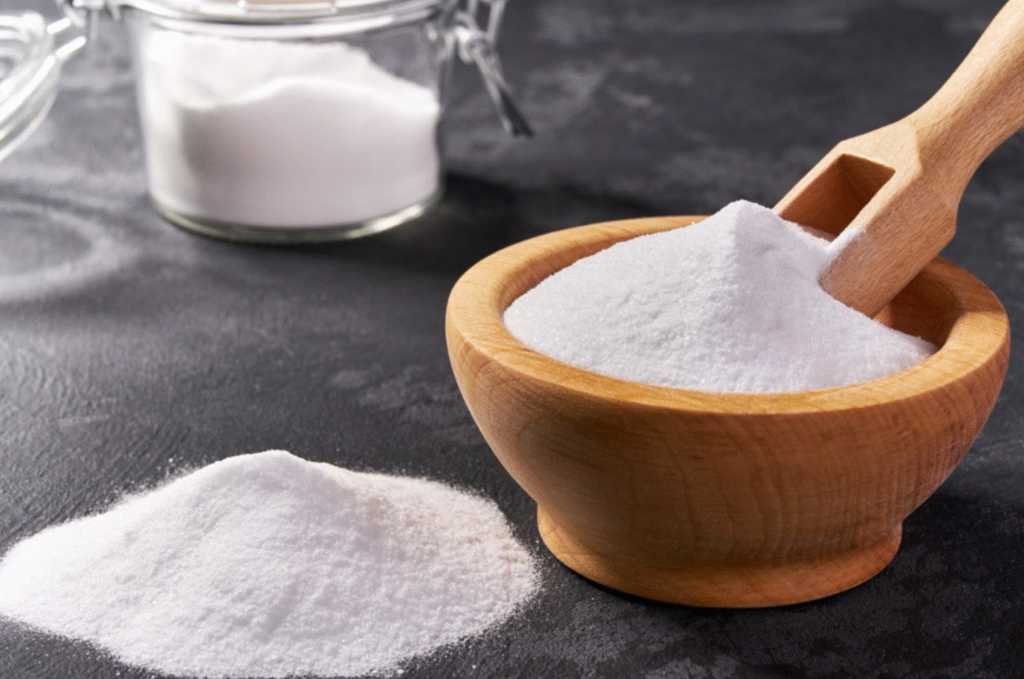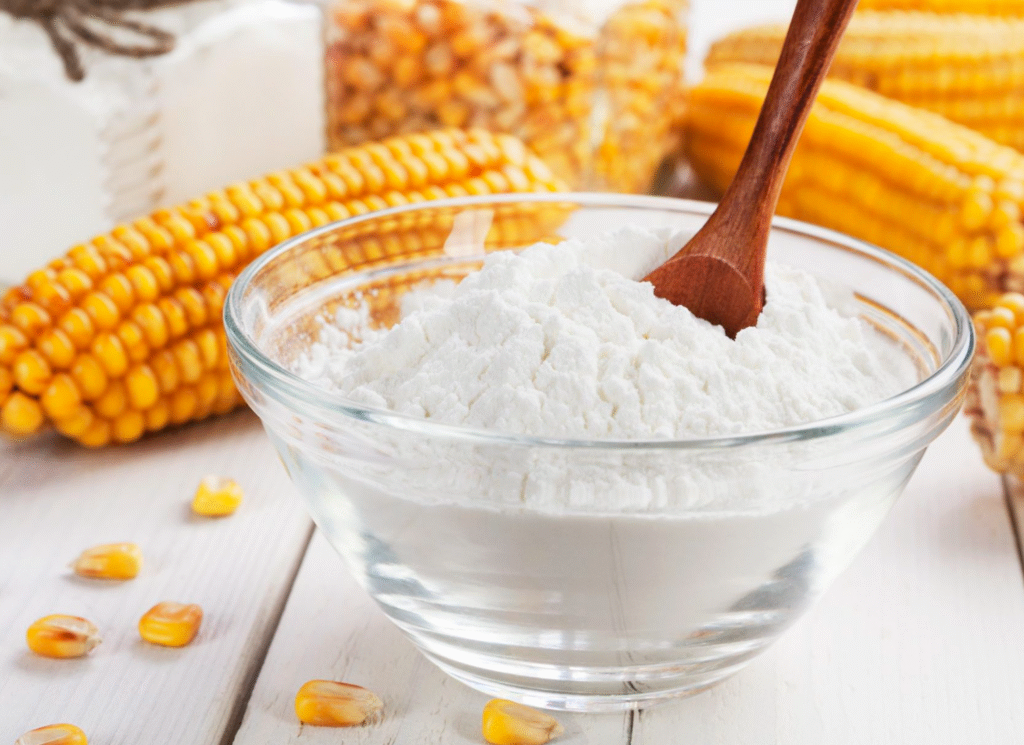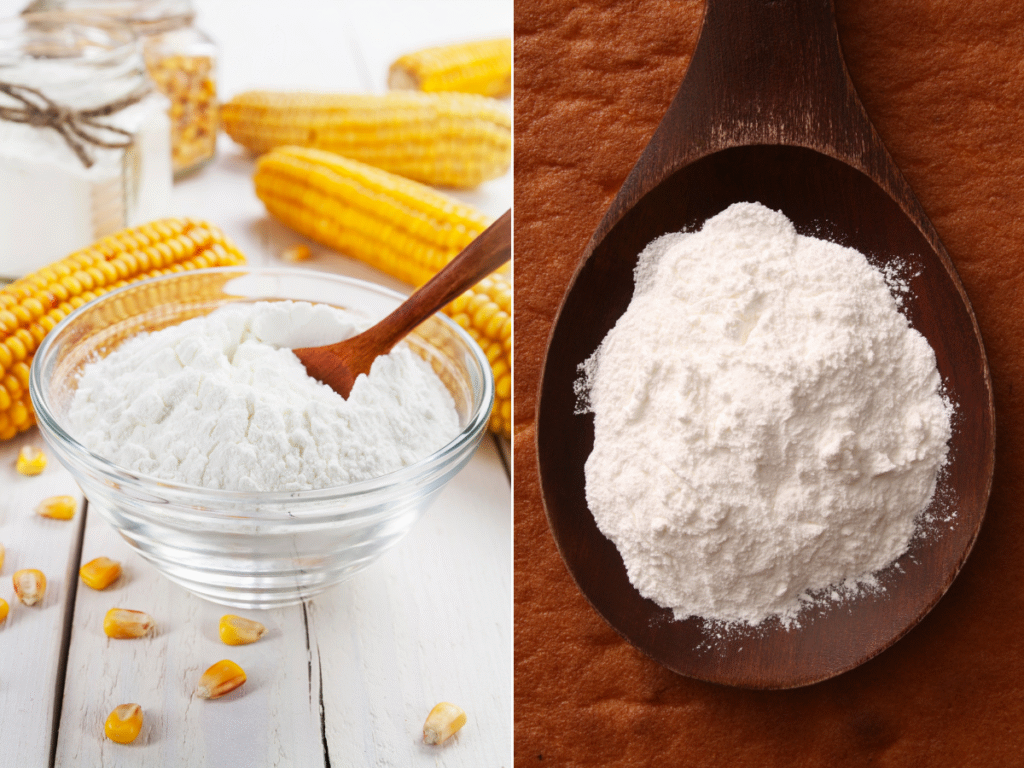Table of Contents
Which is the best baking powder to use in your recipes – baking powder vs cornstarch? Both have their pros and cons, so which one is right for you? In this blog post, we’ll break down the differences between these two ingredients and help you decide which one is best for your next baking project.
What is Baking Powder?
Baking powder is a dry chemical leavening agent that is used to make baked goods rise. It is made up of baking soda, cream of tartar, and cornstarch. When it is mixed with wet ingredients, it reacts and forms carbon dioxide gas. This gas causes the baked goods to rise and become fluffy.

Properties Of Baking Powder
Baking powder is a leavening agent that is used to make baked goods rise. It is made up of baking soda, cream of tartar, and starch. Baking powder is a dry mixture that can be stored at room temperature for up to two years.
When baking powder is mixed with wet ingredients, it starts to react and form bubbles. These bubbles help to lift the batter or dough and create a light and fluffy texture. Baking powder also helps cakes and cookies to brown more evenly.
There are two types of baking powder- single acting and double acting. Double acting baking powder reacts both when it is heated and again when it comes into contact with moisture, whereas single acting baking powder starts to react as soon as it comes into contact with moisture.
Baking powder is a safe and easy way to leaven baked goods. It is available at most grocery stores, and comes in both generic and brand name versions.
Uses For Baking Powder
There are many different ways to use baking powder in your cooking and baking. Here are a few of our favorites:
- In pancakes or waffles, baking powder helps them to rise and become fluffy.
- Baking powder can be used to make biscuits, rolls, and other baked goods light and fluffy.
- Adding a little baking powder to dough or batter can help it to rise more quickly, which is perfect for quick breads like banana bread or zucchini bread.
- Baking powder can also be used as a leavening agent in recipes that call for yeast, like pizza dough or cinnamon rolls.
- If you’re looking for a substitute for eggs in a recipe, try using baking powder instead. One teaspoon of baking powder can replace one egg.
- Baking powder is also a great way to add extra lift to cakes and cupcakes.
How Baking Powder Works
The baking powder is a leavening agent that helps in the expansion of dough by releasing carbon dioxide gas. The baking powder is a combination of an acid and a base, such as cream of tartar and sodium bicarbonate. When these two ingredients are combined, they react to form carbon dioxide gas. This gas is what helps to leaven the dough and create light and fluffy baked goods.
How to Use Baking Powder
Baking powder is a leavening agent that is used to make baked goods such as cakes, cookies, and muffins rise. It can also be used to give a light and airy texture to doughs. Baking powder is available at most grocery stores.
To use baking powder, mix together the dry ingredients (flour, sugar, baking powder) in a bowl. Add wet ingredients (eggs, butter, milk) and mix until well combined. Baked goods should be baked at a high temperature for a short amount of time for best results.
What is Cornstarch?
Cornstarch is a powdery substance that is derived from corn. It is used in cooking as a thickening agent and can also be used to prevent sticking. Cornstarch is gluten-free, making it a good option for people who have gluten sensitivities. It can also be used as a dusting agent to prevent sticking.

Cornstarch Properties
Cornstarch is a fine, white powder that is made from the endosperm of corn kernels. It has many properties that make it an important ingredient in food and other products.
Some of the key properties of cornstarch include:
- It is a thickener, which means it can be used to thicken sauces, gravies, and soups.
- It is a stabilizer, which means it can keep foods from separating or changing consistency.
- It is a moisture absorber, which means it can absorb moisture and help keep foods from becoming soggy.
- It has a neutral flavor and odor, so it doesn’t alter the taste or smell of foods.
- It is a non-allergenic ingredient, so it is safe for people with food allergies.
Cornstarch Uses
Cornstarch is a common, everyday item that has many uses. Some of these include:
- As a thickener for sauces and gravies
- In baking to keep things like cakes and cookies from becoming too dense
- To make homemade ice cream
- To dust with to prevent sticking when frying foods
- As a remedy for stomach aches (mix with water and drink)
- To help relieve itching caused by poison ivy or other skin irritations (mix with water and apply to the area)
- As a natural face wash (mix with water to form a paste)
- To help remove grease and dirt from kitchen surfaces (mix with hot water)
- To make a non-toxic, all-purpose cleaner (mix with water and vinegar)
- As a natural moisturizer for hands and feet (mix with olive oil or coconut oil)
How Cornstarch Works
When cornstarch is mixed with a liquid, it forms a thick paste. This happens because the starch granules in cornstarch swell up and absorb water. The paste will continue to thicken as more starch granules absorb water.
One of the things that makes cornstarch so versatile is its ability to thicken at different temperatures. A warm mixture will thicken more quickly than a cold one. This means that you can make a sauce or gravy while your food is still cooking, without having to wait for it to cool down.
Cornstarch also has a high starch content, which means that it can absorb a lot of water. This makes it a good thickener for dishes that have a lot of liquid in them. It can also help to prevent sauces and gravies from becoming too thin.
When you are ready to serve a dish that contains cornstarch, you will need to stir it well. This will help to make sure that the cornstarch is evenly distributed and that there are no clumps. If you do not stir the dish well, you may end up with a sticky mess on your plate.
How to Use Cornstarch?
Cornstarch is a versatile ingredient that can be used in both sweet and savory dishes. It can be used to thicken sauces, gravies, and soups, or to add flavor and texture to desserts. Here are some tips on how to use cornstarch:
- To thicken a sauce, gravy, or soup, mix 1 tablespoon of cornstarch with 2 tablespoons of water. Stir the mixture into the sauce or soup until it thickens.
- To add flavor and texture to a dessert, mix 1 tablespoon of cornstarch with 2 tablespoons of milk. Stir the mixture into the dessert until it thickens.
- To make a glaze, mix 1 tablespoon of cornstarch with 1/4 cup of water. Stir the mixture into the glaze until it thickens.
- To prevent sauce or gravy from sticking to a pan, add a thin layer of cornstarch to the pan before adding the sauce or gravy.
- To prevent lumps in a sauce or gravy, mix the cornstarch with a small amount of cold liquid before adding it to the hot liquid.
How is Cornstarch Different From Baking Powder?
Cornstarch and baking powder are both leavening agents, but they have different purposes in baking.
Cornstarch is used to thicken and stabilize sauces, pie fillings, and gravies. It also helps to produce a smooth texture.
Baking powder is used to help cakes and other baked goods rise. It contains baking soda, which reacts with acids in the batter to produce carbon dioxide gas. This gas expands and makes the food light and fluffy.
If you are using a recipe that calls for cornstarch, you can substitute baking powder, but be aware that your results may not be exactly the same.
FAQs on Baking Powder vs Cornstarch
Are baking powder and cornstarch the same thing?
A lot of people seem to think that baking powder and cornstarch are the same thing, but they are actually quite different. Baking powder is a leavening agent, while cornstarch is a thickening agent.
Cornstarch, cream of tartar, and baking soda make up baking powder. The baking soda and cream of tartar react with each other to form bubbles of carbon dioxide gas. The gas bubbles cause the dough or batter to rise, resulting in a light and fluffy baked good. Cornstarch helps to keep the baking powder from reacting too early, which could cause the baked good to fall flat.
Cornstarch is made from ground corn kernels. It is used to thicken sauces, soups, and other dishes. When it is heated, the starch molecules swell and thicken the liquid. Cornstarch can also be used to coat food items before frying them, which helps to keep them from sticking to the pan.
So, are baking powder and cornstarch the same thing? No, they are not the same thing. Baking powder is a leavening agent, while cornstarch is a thickening agent. Baking powder contains baking soda and cream of tartar, while cornstarch contains ground corn kernels.
Can you Replace Baking Powder with Cornstarch?
Some say that it can be done, while others maintain that it will not work.
In general, however, most people seem to think that using cornstarch as a replacement for baking powder will produce results that are less than desirable. This is because cornstarch does not have the same properties as baking powder, which means that it will not create the same level of lift and volume in your baked goods.
As a result, your cakes or other desserts may end up being dense or heavy. If you are looking for a way to avoid using baking powder, there are other alternatives that you can try, such as using soda or vinegar.
What happens if you don’t use baking powder?
If you don’t use baking powder when you bake, your food might not turn out the way you want it to. This is because baking powder helps your food rise and get fluffy, so if you don’t use it, your food might be dense or gooey. You might also end up with a bad taste in your mouth if you don’t use baking powder. So if you’re looking for fluffy, delicious baked goods, make sure to add baking powder to the recipe!
Can I skip baking powder in a recipe?
Yes, you can definitely omit baking powder in a recipe, but it may not turn out as desired. Baking powder is a leavening agent that helps baked goods rise by providing gas bubbles. If you don’t have any on hand or choose to leave it out, your food may be dense or gooey.
You can try adding an extra egg or another leavening agent like yeast if you’re looking to avoid using baking powder. In general, it’s a good idea to have some on hand just in case, but there are times when it can be safely omitted. Just be sure to test your recipe before serving to make sure everything turns out okay!

Is corn starch and corn flour the same?
Cornstarch and corn flour are both made from ground maize, but they have different uses. Cornstarch is used as a thickener in sauces, stews, and gravies, while corn flour is used to make breads, pastas, and other baked goods. Corn starch has a higher starch content than corn flour, so it can provide a thicker texture. Corn flour is also finer in texture than corn starch.
There are also variations of these two flours depending on how they are ground. For example, fine-ground cornstarch is great for thickening delicate sauces while medium-ground cornstarch is perfect for gravies and roux. Coarse-ground cornstarch works well in batters and breading.
Conclusion
No matter which type of baking powder you choose, make sure to store it in a cool, dry place so it stays fresh. Have you tried using cornstarch or another alternative to baking powder in your recipes? Thank you for reading “Baking Powder vs Cornstarch: Which One is Best?”
Read more articles at Ohsnap Cupcakes!